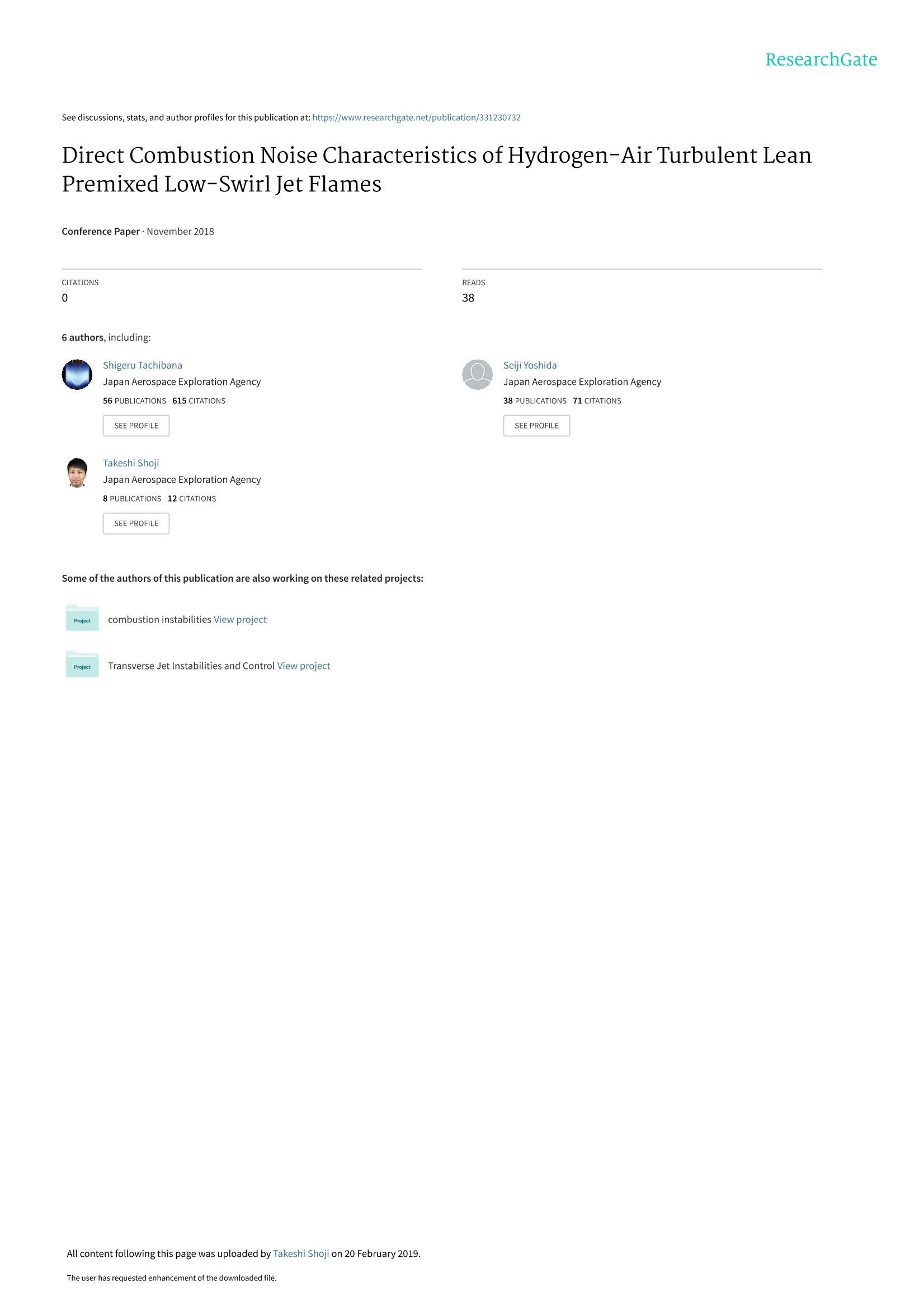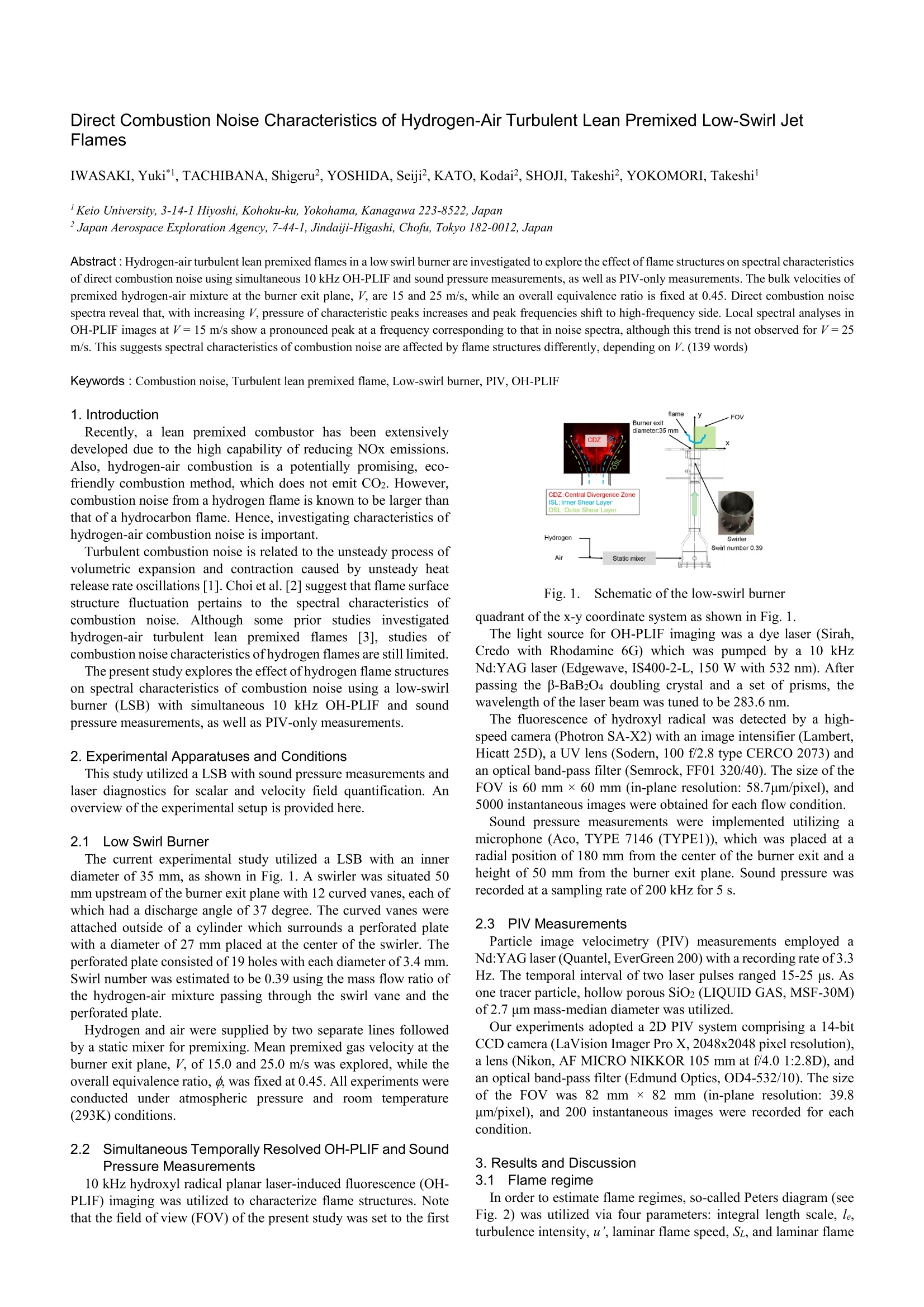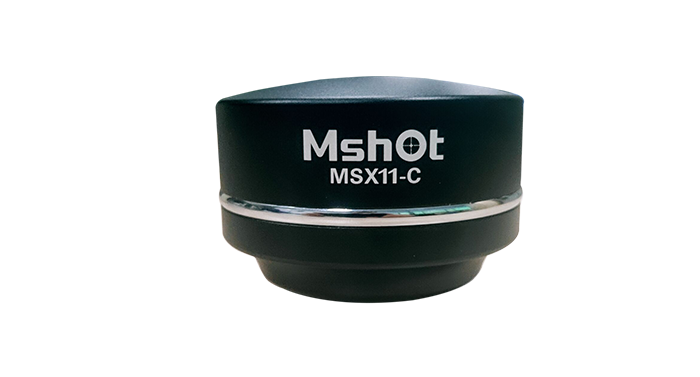方案详情
文
采用LaVision公司的ImagerProX相机构成一套PIV和PLIF联合测量装置,并利用该装置进行了氢-空气湍流贫预混低旋流射流火焰直接燃烧噪声特性的研究。
方案详情

ResearchGateSee discussions, stats, and author profiles for this publication at: https://www.researchgate.net/publication/331230732All content following this page was uploaded by Takeshi Shoji on 20 February 2019.The user has requested enhancement of the downloaded file. Direct Combustion Noise Characteristics of Hydrogen-Air Turbulent LeanPremixed Low-Swirl Jet Flames Conference Paper·November 2018 CITATIONS0 READS38 6 authors, including: Shigeru Tachibana Seiji Yoshida Japan Aerospace Exploration Agency Japan Aerospace Exploration Agency 38 PUBLICATIONS 71 CITATIONS SEE PROFILE Takeshi Shoji Japan Aerospace Exploration Agency 8 PUBLICATIONS 12 CITATIONS SEE PROFILE Some of the authors of this publication are also working on these related projects: Project combustion instabilities View project Project Transverse Jet Instabilities and Control View project Direct Combustion Noise Characteristics of Hydrogen-Air Turbulent Lean Premixed Low-Swirl JetFlames IWASAKI, Yuki*, TACHIBANA, Shigeru?, YOSHIDA, Seiji, KATO,Kodai?, SHOJI, Takeshi, YOKOMORI, Takeshil 'Keio University, 3-14-1 Hiyoshi, Kohoku-ku, Yokohama, Kanagawa 223-8522, Japan Japan Aerospace Exploration Agency, 7-44-1, Jindaiji-Higashi, Chofu, Tokyo 182-0012,Japan Abstract:Hydrogen-air turbulent lean premixed flames in a low swirl burner are investigated to explore the effect of flame structures on spectral characteristicsof direct combustion noise using simultaneous 10 kHz OH-PLIF and sound pressure measurements, as well as PIV-only measurements. The bulk velocities ofpremixed hydrogen-air mixture at the burner exit plane, V, are 15 and 25 m/s, while an overall equivalence ratio is fixed at 0.45. Direct combustion noisespectra reveal that, with increasing V, pressure of characteristic peaks increases and peak frequencies shift to high-frequency side. Local spectral analyses inOH-PLIF images at V=15 m/s show a pronounced peak at a frequency corresponding to that in noise spectra, although this trend is not observed for V=25 m/s. This suggests spectral characteristics of combustion noise are affected by flame structures differently, depending on V. (139 words) Keywords : Combustion noise, Turbulent lean premixed flame, Low-swirl burner, PIV, OH-PLIF 1. Introduction Recently, a lean premixed combustor has been extensivelydeveloped due to the high capability of reducing NOx emissions.Also, hydrogen-air combustion is a potentially promising, eco-friendly combustion method, which does not emit CO2. However,combustion noise from a hydrogen flame is known to be larger thanthat of a hydrocarbon flame. Hence, investigating characteristics ofhydrogen-air combustion noise is important. Turbulent combustion noise is related to the unsteady process ofvolumetric expansion and contraction caused by unsteady heatrelease rate oscillations [1]. Choi et al. [2] suggest that flame surfacestructure fluctuation pertains to the spectral characteristics ofcombustion noise. Although some prior studies investigatedhydrogen-air turbulent lean premixed flames [3], studies ofcombustion noise characteristics ofhydrogen flames are still limited. The present study explores the effect ofhydrogen flame structureson spectral characteristics of combustion noise using a low-swirlburner (LSB) with simultaneous 10 kHz OH-PLIF and soundpressure measurements, as well as PIV-only measurements. 2. Experimental Apparatuses and Conditions This study utilized a LSB with sound pressure measurements andlaser diagnostics for scalar and velocity field quantification. Anoverview of the experimental setup is provided here. 2.1 Low Swirl Burner The current experimental study utilized a LSB with an innerdiameter of 35 mm, as shown in Fig. 1. A swirler was situated 50mm upstream of the burner exit plane with 12 curved vanes, each ofwhich had a discharge angle of 37 degree. The curved vanes wereattached outside of a cylinder which surrounds a perforated platewith a diameter of 27 mm placed at the center of the swirler. Theperforated plate consisted of 19 holes with each diameter of 3.4 mm.Swirl number was estimated to be 0.39 using the mass flow ratio ofthe hydrogen-air mixture passing through the swirl vane and theperforated plate. Hydrogen and air were supplied by two separate lines followedby a static mixer for premixing. Mean premixed gas velocity at theburner exit plane, V, of 15.0 and 25.0 m/s was explored, while theoverall equivalence ratio, d, was fixed at 0.45. All experiments wereconducted under atmospheric pressure and room temperature(293K) conditions. 2.2Simultaneous Temporally Resolved OH-PLIF and SoundPressure Measurements 10 kHz hydroxyl radical planar laser-induced fluorescence (OH-PLIF) imaging was utilized to characterize flame structures. Notethat the field of view (FOV) of the present study was set to the first Fig. 1.SSchematic of the low-swirl burner quadrant of the x-y coordinate system as shown in Fig. 1. The light source for OH-PLIF imaging was a dye laser (Sirah,Credo with Rhodamine 6G) which was pumped by a 10 kHzNd:YAG laser (Edgewave, IS400-2-L, 150 W with 532 nm). Afterpassing the B-BaB2O4 doubling crystal and a set of prisms, thewavelength of the laser beam was tuned to be 283.6 nm. The fluorescence of hydroxyl radical was detected by a high-speed camera (Photron SA-X2) with an image intensifier (Lambert,Hicatt 25D), a UV lens (Sodern, 100 f/2.8 type CERCO 2073) andan optical band-pass filter (Semrock, FF01 320/40). The size of theFOV is 60 mm×60 mm (in-plane resolution: 58.7um/pixel), and, 5000 instantaneous images were obtained for each flow condition. Sound pressure measurements were implemented utilizing amicrophone (Aco, TYPE 7146 (TYPE1)), which was placed at aradial position of 180 mm from the center of the burner exit and aheight of 50 mm from the burner exit plane. Sound pressure wasrecorded at a sampling rate of 200 kHz for 5 s. 2.3 PIV Measurements Particle image velocimetry (PIV) measurements employed aNd:YAG laser (Quantel, EverGreen 200) with a recording rate of 3.3Hz. The temporal interval of two laser pulses ranged 15-25 us. Asone tracer particle, hollow porous SiO2 (LIQUID GAS, MSF-30M)of 2.7 um mass-median diameter was utilized. Our experiments adopted a 2D PIV system comprising a 14-bitCCD camera (LaVision Imager Pro X, 2048x2048 pixel resolution),a lens (Nikon, AF MICRO NIKKOR 105 mm at f/4.0 1:2.8D), andan optical band-pass filter (Edmund Optics,OD4-532/10). The sizeof the FOV was 82 mm x 82 mm (in-plane resolution: 39.8um/pixel), and 200 instantaneous images were recorded for eachcondition. 3. Results and Discussion 3.1 Flame regime In order to estimate flame regimes, so-called Peters diagram (seeFig. 2) was utilized via four parameters: integral length scale, leturbulence intensity, u', laminar flame speed, St, and laminar flame thickness, 8. Results of PIV/ measurements inn non-reactiveflowfields were utilized to obtain integral length scale, using two-point correlations, and turbulence intensity. The integral scale basedon vertical velocity fluctuation was estimated along the y directionwithin interrogation areas of 1-pixel width. Interrogation areas werelocated at x locations from 0 to 20 mm with the increment of 4 mm.Turbulence intensity, the ratio of the root-mean-square of thevelocity fluctuations to mean velocity, was evaluated withininterrogation areas at the same central locations as the integral lengthscale but with 4 mm widths in the x direction and the height from y= 15 mm to 25 mm. Laminar flame speed was calculated byCHEMKIN-PREMIX using the GRI-Mech 3.0. The remainingquantity, o, was estimated as the ratio of kinetic viscosity ofpremixed mixture to Sz, following the approach in [4]. Using these parameters, flame structures were classified into the“corrugated flamelets” regime as shown in Fig. 2 for both V=15and 25 m/s. Note that there are six data points at a given V becauseintegral length scale and turbulence intensity were estimated at sixdifferent x locations. Fig. 22.Peters diagram for V= 15 and 25 m/s 3.2 Sound Pressure Spectral Characteristics In order to study spectral characteristics of combustion noise,spectral analyses were applied to sound pressure data. To eliminatethe effect of noise that is irrelevant to combustion noise, cold flownoise spectra obtained from non-reactive flowfields were subtractedfrom original spectra. Fig. 3 shows the power spectral density (PSD)of pressure fluctuations for V=15 and 25 m/s, with the frequencyresolution of 10 Hz. As one can see, several prominent peaks’amplitudes increase with frequency-shifting to higher-frequencyside, e.g.,the highest peak at fi=480 Hz for V=15 m/s to f2=790Hz for V= 25 m/s. Remarkably, the rate of the change in peakfrequency with the highest amplitude (f/ fi) is nearly equivalent tothat of the mixture velocity. Such quantitative trend is consistentwith results in [5], considering that a flame length does notsignificantly vary between these two conditions in this study. Fig.3.5.FPSD of pressure fluctuation for V=15 and 25 m/s 3.3Spectral Characteristics of Flame Structural FluctuationResults from temporally resolved OH-PLIF imaging were utilizedto determine the probability of flame locations for each V and toestimate a fundamental frequency of large-scale flame surfacefluctuation. For the probability of flame locations, flame surface wasfirst detected in each instantaneous image using the same method in [3]. Based on the flame surface, we defined flame surface probability(FSP) as follows: where i is the column index, j is the row index, Nflame surface (i,j) is thenumber of images where flame surface exists at the pixel location(i,j), and Nimages is the total number of images. FSP represents theprobability of the existence of the flame surface at each pixel over5000 snapshots. Figs.4 (al) and (b1) show the FSP maps for V=15m/s and 25 m/s, respectively. To explore a fundamental frequency of flame surface fluctuation,spectral analyses were applied to flame surface density (FSD),which was locally estimated inside a region of interest (ROI). TheFSD is defined as the ratio of flame edge length inside the ROI tothe area of ROI. The center of ROI coincided with spatial locationswith the highest FSP value in Figs. 4 (al) and (b1). Red squares inFigs. 4 (a1) and (b1) show the locations of ROI in the FSP maps atV= 15 and 25 m/s, and Figs.4 (a2) and (b2) represent spectra ofFSD with a frequency resolution of 10 Hz. In Figs. 4(a2) and (b2), both spectra consist of a peak around 500Hz. For V = 15 m/s, the 490 Hz peak in the FSD spectrumcorresponds to the 480 Hz peak in Fig. 3, suggesting a relationshipbetween combustion noise and large-scale flame surface fluctuationaround a flame shear layer. However, for V=25 m/s, there is nocoincidence between the peak frequency in the FSD spectrum andFig.. .3. To elucidate this discrepancy between V= 15 and 25 m/s,more in-depth exploration will be required. Interestingly, in Fig. 4(b2), another pronounced peak is observed at 1010 Hz. This peakmay be associated with smaller-scale flame surface fluctuationinduced by higher turbulence intensity at V=25 m/s although furtherinvestigation will be required to confirm this speculation. Fig. 4. (a1, b1) FSP from 5000 OH-PLIF images, and (a2, b2) FSDspectra in each ROI. (a1,2) V=15 m/s,and (b1,2) V=25 m/s. 4. Conclusions 1. With increasing the mixture velocity, several pronounced peaks’amplitude increased, with frequency-shifting to high-frequencyside. The increase ratio in the peak frequency approximatelyequaled the mixture velocity ratio, consistent with [5]. 2. For V=15m/s, the peak frequency in FSD spectra showedremarkable correspondence to that in sound pressure spectra,while this trend was not consistent for V= 25 m/s. Suchdiscrepancy might be attributed to flame surface fluctuationoccurring with different length scales. References AA. P. Dowlinget al., Proc. Combust. Inst. (2015)65-100.2C3M. Day et al.,Combust. Flame. 162 (2015)2148-2165.45 G. Choi. et al., Proc. Combust. Inst. 30 (2005)1807-1814. N. Peters,J. Fluid Mech. 384 (1999)107-132. Hydrogen-air turbulent lean premixed flames in a low swirl burner are investigated to explore the effect of flame structures on spectral characteristics of direct combustion noise using simultaneous 10 kHz OH-PLIF and sound pressure measurements, as well as PIV-only measurements. The bulk velocities of premixed hydrogen-air mixture at the burner exit plane, V, are 15 and 25 m/s, while an overall equivalence ratio is fixed at 0.45. Direct combustion noise spectra reveal that, with increasing V, pressure of characteristic peaks increases and peak frequencies shift to high-frequency side. Local spectral analyses in OH-PLIF images at V = 15 m/s show a pronounced peak at a frequency corresponding to that in noise spectra, although this trend is not observed for V = 25 m/s. This suggests spectral characteristics of combustion noise are affected by flame structures differently, depending on V.
确定



还剩1页未读,是否继续阅读?
北京欧兰科技发展有限公司为您提供《射流火焰中10 kHz 高频平面激光诱导荧光(OH-PLIF)检测方案(气体流量计)》,该方案主要用于煤炭中10 kHz 高频平面激光诱导荧光(OH-PLIF)检测,参考标准--,《射流火焰中10 kHz 高频平面激光诱导荧光(OH-PLIF)检测方案(气体流量计)》用到的仪器有PLIF平面激光诱导荧光火焰燃烧检测系统、德国LaVision PIV/PLIF粒子成像测速场仪、LaVision IRO 图像增强器、LaVision DaVis 智能成像软件平台
推荐专场
CCD相机/影像CCD
更多
相关方案
更多
该厂商其他方案
更多

























